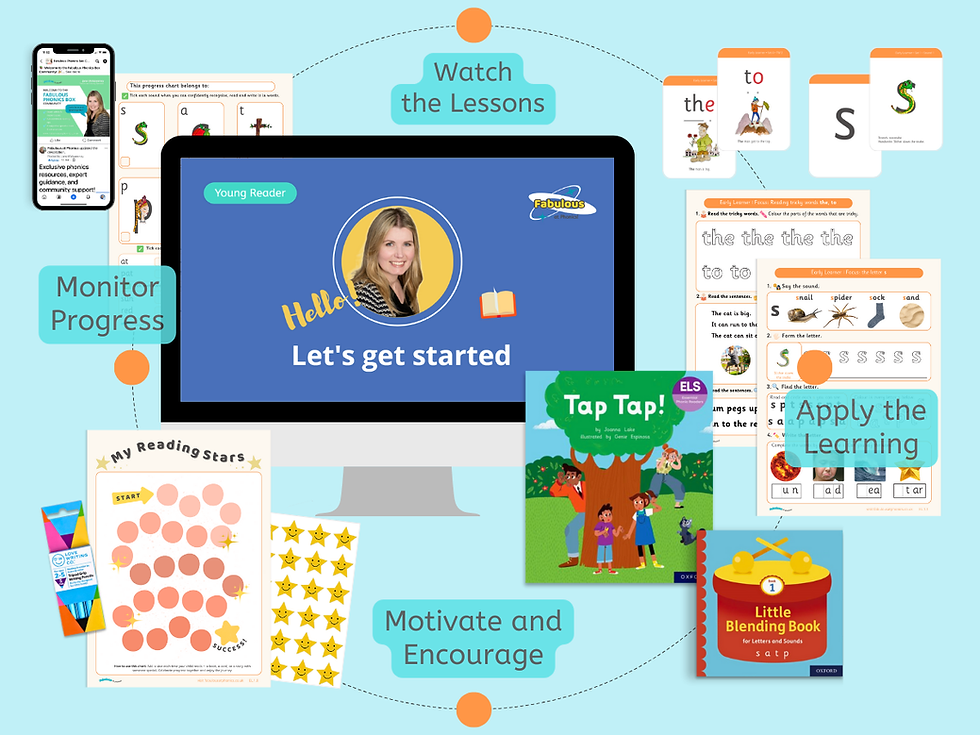Real-Life Photographs in Early Learning: Why They Matter
- Fabulous at Phonics!

- Oct 9
- 3 min read
🌿 Gentle Introduction “When Ollie spotted a photo of an apple on his sound sheet, he whispered, ‘That’s mine.’”
It wasn’t his actual apple but it looked familiar enough to spark recognition, pride, and a quiet sense of belonging.
That’s the power of mapped visuals:
Real images.
Real connections. 🧠 Why It Matters Real-life photographs help children anchor learning to their world.
They boost vocabulary, memory, and emotional safety, especially in the early years.
They support EYFS goals like Understanding the World and Communication & Language, gently bridging abstract concepts with lived experience. 🧩 How We Use Them On activity sheets:
To show real objects, actions, and emotions children recognise.

In lesson videos:
To anchor phonics, segmentation, blending, and vocabulary in familiar visuals.

In captions and thumbnails:
To ripple-test emotional clarity and protect trust wherever families see us. That might be on social media, in blog posts, or in lesson previews.

These images aren’t decorative.
They’re mapped for resonance.
Each one is chosen to feel warm, familiar, and emotionally safe. ✋ Gentle Tips for Educators
Use photographs of everyday objects children already know, like shoes, cups, or snacks.
These familiar visuals help children feel safe, seen, and ready to learn.
Avoid overly stylised or fantastical images in the early stages. They can confuse or distract, especially when children are still anchoring sounds to meaning. Encourage families to notice what their child recognises.
Those quiet “I know that!” moments build confidence and connection.
They show that mapped learning is landing in a way that feels personal and safe. These mapped choices aren’t just practical. They’re backed by what we know about how children learn. 🔬 The Science Behind the Snap Even very young children begin to recognise objects in photographs long before they can read.
Seeing both a photo and the real object strengthens memory, vocabulary, and understanding.
Mapped visuals help children say:
“I know that.”
“I’ve seen that.”
“That’s mine.” 🌱 Practice in Action In Fabulous at Phonics lesson videos and activity sheets, real-life photographs do more than decorate. They help children connect learning to their world, visually, emotionally, and practically.
Each image is chosen with care:
To feel familiar, not stylised
To support motor memory and sound segmentation
To build emotional safety and trust
Every visual is ripple-tested for clarity and resonance. Visuals are batched with inbox safety in mind so families receive warm, mapped content that feels calm, not cluttered.
📚 Choosing Books with Real Photographs At Fabulous at Phonics, we also choose books that feature real-life photographs, especially in the early stages of learning.
These images help children anchor new words to familiar objects, actions, and emotions.
They strengthen vocabulary, support sound awareness, and protect emotional safety.
When children see a real image of a dog, a shoe, or a snack (something they recognise from their own world) they’re more likely to respond with recognition:
“That’s like mine.”
“I’ve seen that before.”
“I know what that is.”
This mapped recognition matters.
It helps children read the word with confidence because the image feels familiar and clear.
And it encourages writing too: children are more likely to attempt spelling a word they’ve seen, said, and connected to something real.
Real photographs build trust.
They spark curiosity.
They quietly support phonics, early vocabulary, and first writing steps.
🏡 Gentle Reflections for Families Real-life photographs help children feel seen. They spark recognition, pride, and curiosity, especially when the image feels familiar.
Families might notice their child pointing to a photo and saying, “I’ve got that!” or “That’s like mine.” These moments matter.
They show that learning is landing in a way that feels safe and personal.
There’s no need to prep or print anything extra.
Just notice what your child recognises.
That quiet “I know that” moment is where learning begins. 🌿 Want to explore mapped visuals in action?
💛 Closing Thought
Real photographs aren’t just decoration.
They’re emotional anchors.
They help children feel seen, capable, and curious, including you.


Comments